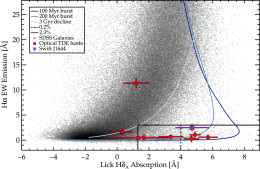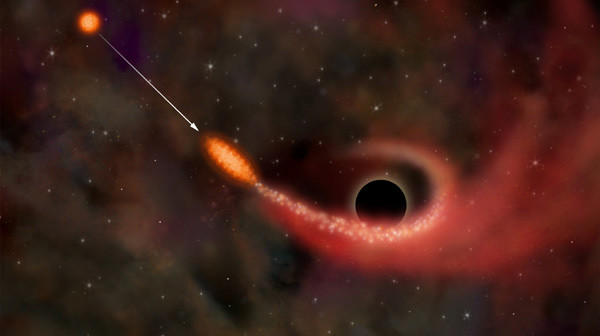Tidal disruption events (TDEs) occur when a star passes a little too close to a supermassive black hole at the center of a galaxy. Tidal forces from the black hole cause the passing star to be torn apart, resulting in a brief flare of radiation as the star’s material accretes onto the black hole. A recent study asks the following question: do TDEs occur most frequently in an unusual type of galaxy?
A Trend in Disruptions
So far, we have data from eight candidate TDEs that peaked in optical and ultraviolet wavelengths. The spectra from these observations have shown an intriguing trend: many of these TDEs’ host galaxies exhibit weak line emission (indicating little or no current star-formation activity), and yet they show strong Balmer absorption lines (indicating star formation activity occurred within the last Gyr). These quiescent, Balmer-strong galaxies likely underwent a period of intense star formation that recently ended.
To determine if TDEs are overrepresented in such galaxies, a team of scientists led by Decker French (Steward Observatory, University of Arizona) has quantified the fraction of galaxies in the Sloan Digital Sky Survey (SDSS) that exhibit similar properties to those of TDE hosts.
Quantifying Overrepresentation

Spectral characteristics of SDSS galaxies (gray) and TDE candidate host galaxies (colored points): line emission vs. Balmer absorption. The lower right-hand box identifies the quiescent, Balmer-strong galaxies — which contain most TDE events, yet are uncommon among the galaxy sample as a whole. Click for a better look! [French et al. 2016]
This means that quiescent galaxies with strong past star formation are overrepresented in the TDE host galaxy sample by a factor of ~190 times. Quiescent galaxies with at least moderately strong past star formation are overrepresented among TDE hosts by a factor of ~33.
Why the Preference?
So why might these galaxies so frequently host TDEs? The authors propose an idea: many of these galaxies may have experienced recent galaxy–galaxy mergers. Such a merger could trigger a burst of star formation, perturb stellar orbits, and then eventually settle into a quiescent state with stars that are more likely to be centrally concentrated and with orbits that might lead them to pass close to the central black hole(s).
Future observations of more TDEs will certainly help to further evaluate this trend. But the current data certainly implies that TDEs are discriminating in their choice of host, providing interesting clues about the mechanisms driving their rates.
Citation
K. Decker French et al 2016 ApJ 818 L21. doi:10.3847/2041-8205/818/1/L21


2 Comments
Pingback: snacks for SMBHs
Pingback: Estrellas destruidas por mareas « SEDA / LIADA